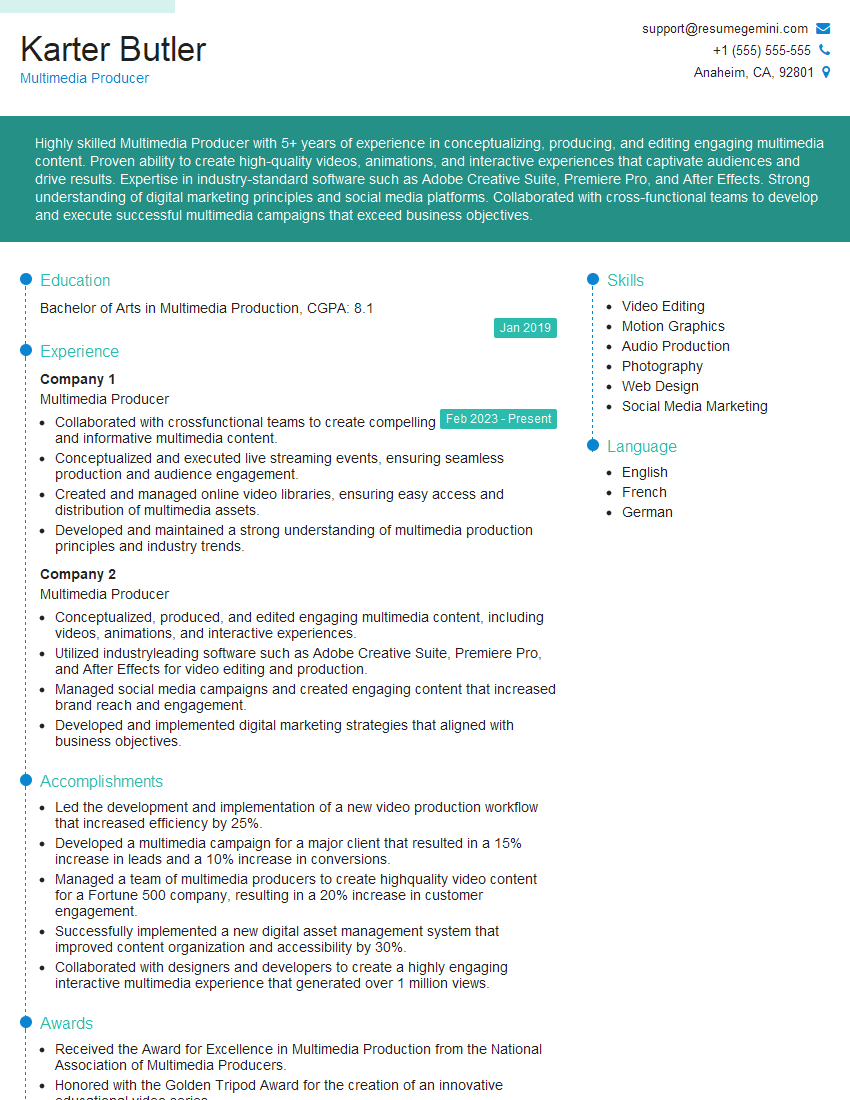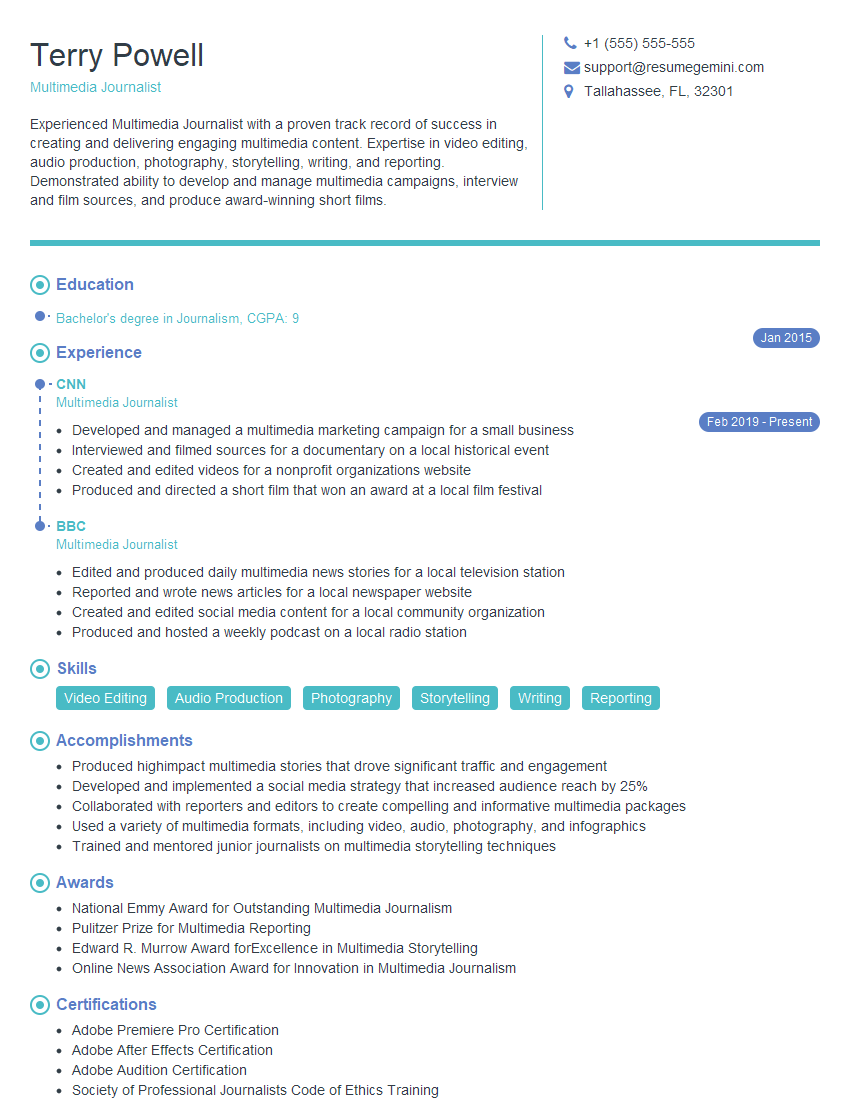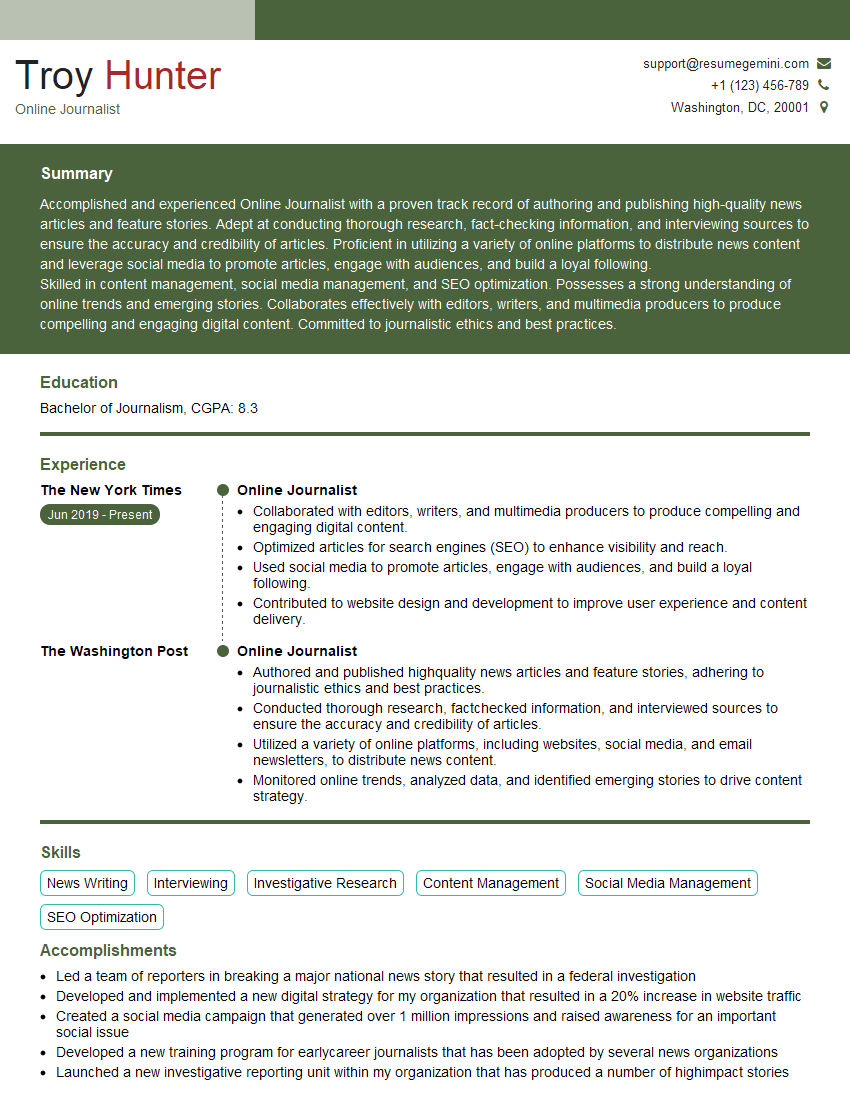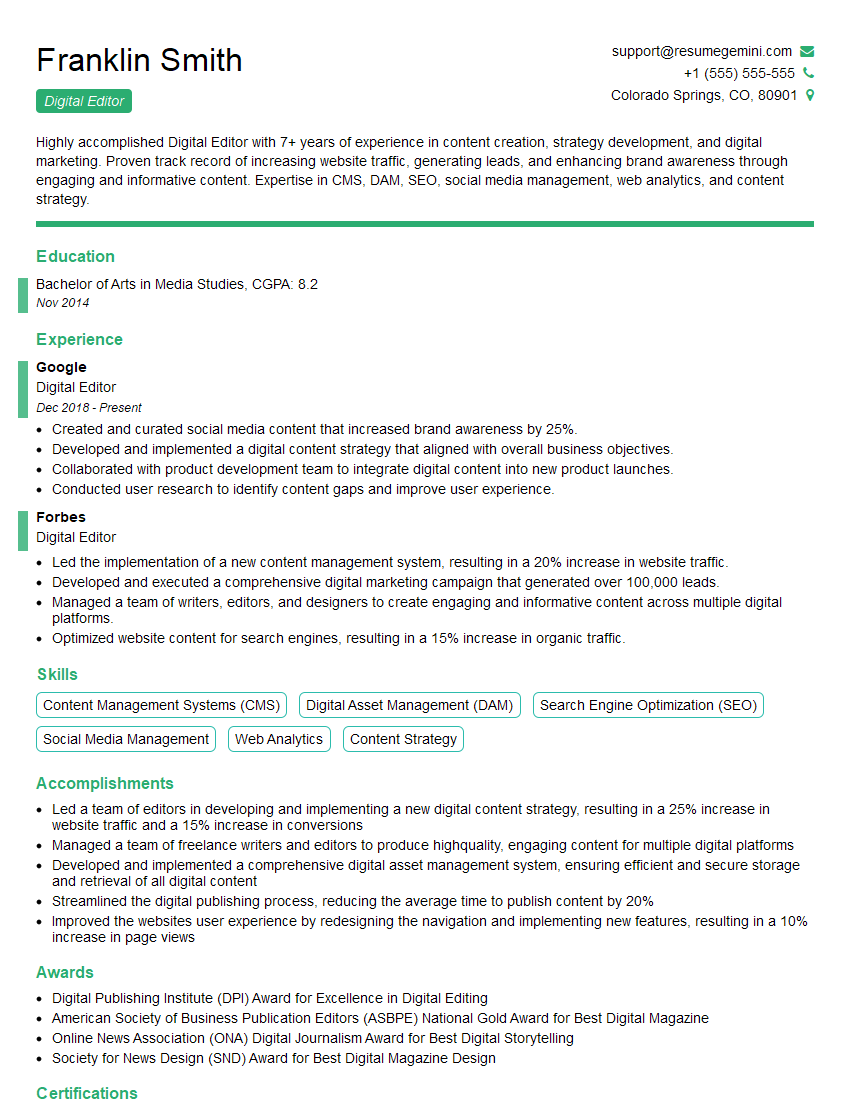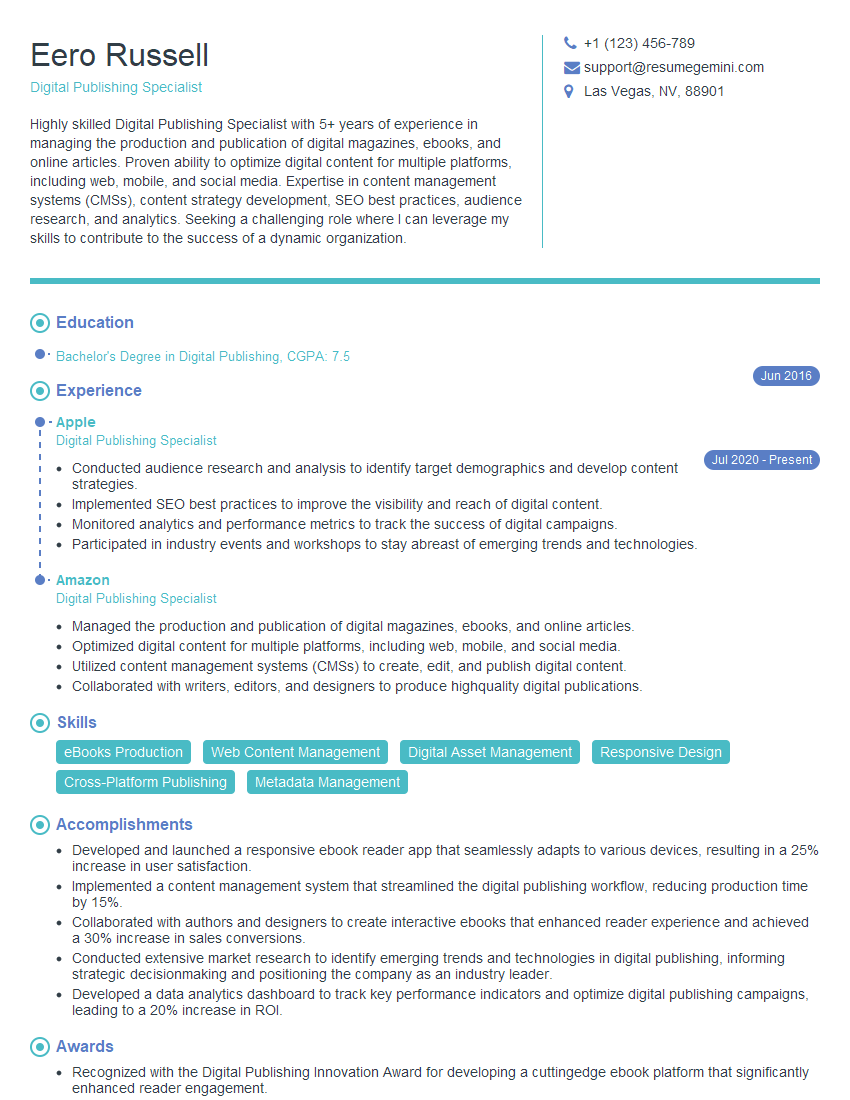Preparation is the key to success in any interview. In this post, we’ll explore crucial Digital Journalism Tools and Techniques interview questions and equip you with strategies to craft impactful answers. Whether you’re a beginner or a pro, these tips will elevate your preparation.
Questions Asked in Digital Journalism Tools and Techniques Interview
Q 1. What are your preferred digital journalism tools for content creation?
My content creation workflow relies on a suite of tools tailored to different stages. For writing and editing, I primarily use Grammarly for grammar and style checks, and Clippings.me for organizing research materials and quotes. For audio and video editing, I utilize Audacity (open-source and versatile) and DaVinci Resolve (powerful, yet user-friendly for professional-grade video). For image editing, GIMP (a free alternative to Photoshop) provides robust features.
These tools are chosen for their balance of functionality, ease of use, and often, cost-effectiveness. For example, while DaVinci Resolve has a learning curve, its capabilities far outweigh the effort invested, enabling high-quality video production without the hefty price tag of industry-standard software.
Q 2. Explain your experience with Content Management Systems (CMS) like WordPress.
I have extensive experience with WordPress, having used it to build and manage numerous news websites and blogs. I’m proficient in both the front-end (user-facing side) and back-end (administrative) aspects. This includes creating custom themes, managing plugins (like SEO plugins and security tools), optimizing website performance for speed and search engines, and ensuring content is easily accessible and well-organized for readers.
For instance, I once worked on a project where we migrated a legacy news site to a more modern WordPress setup. This involved not only transferring content but also optimizing the database, improving site navigation, and implementing a responsive design that catered to different devices. I’m familiar with various WordPress plugins that enhance functionality, from managing user roles to integrating social media feeds.
Q 3. How familiar are you with SEO best practices for journalism?
SEO (Search Engine Optimization) is crucial for ensuring news articles reach the intended audience. My understanding encompasses keyword research (identifying relevant search terms), on-page optimization (optimizing title tags, meta descriptions, and header tags within articles), and off-page optimization (building backlinks from reputable sources). I’m also familiar with schema markup to improve search engine understanding of the content.
For example, when writing about a local election, I’d research relevant keywords like “[city name] election results,” “[candidate name] platform,” etc. I’d then incorporate these keywords naturally within the article’s title, headings, and body text. I’d also ensure the article has a concise, compelling meta description summarizing the key information. This holistic approach significantly increases the chances of the article appearing high in search results.
Q 4. Describe your approach to social media strategy for news dissemination.
My social media strategy focuses on a multi-platform approach, adapting the content to the specific platform’s nuances. For breaking news, Twitter is ideal for immediate updates, while Facebook allows for more detailed stories and engaging community interaction. Instagram can be used effectively for visual storytelling through photos and videos, especially if the news involves impactful imagery. LinkedIn can be leveraged for news related to business or politics.
For example, for a breaking news story, I’d craft a concise and informative Tweet with a link to the full article. On Facebook, I’d add a more detailed description, potentially including images or a short video. I use analytics tools to monitor engagement and tailor my approach based on what resonates with the audience. The key is consistency and offering value to the followers, not just pushing news.
Q 5. What is your experience with data visualization tools for journalistic storytelling?
Data visualization is a powerful tool for making complex information accessible and engaging. I’m experienced with tools like Tableau and Datawrapper. These platforms allow me to transform raw data into interactive charts, graphs, and maps, enhancing the storytelling aspect of journalism.
For instance, while reporting on economic inequality, I might use Tableau to create an interactive map visualizing income disparities across different regions. This visual representation would instantly convey the information more effectively than a text-heavy explanation. The choice of visualization tool depends on the complexity of data and the desired level of interactivity.
Q 6. How do you ensure accuracy and verification of information in a digital context?
Accuracy and verification are paramount. My approach involves multiple layers of fact-checking. This starts with sourcing information from reputable and reliable sources, cross-referencing information with multiple sources to avoid bias, and verifying the identities of individuals involved. I also utilize tools such as reverse image search to check for image manipulation and fact-checking websites to verify claims.
If dealing with controversial claims, I would reach out directly to the relevant parties for their input, ensuring balanced reporting. Transparency is key; clearly citing sources within the article builds trust with the audience and allows for accountability. Documenting the verification process is crucial for journalistic integrity.
Q 7. Explain your understanding of ethical considerations in digital journalism.
Ethical considerations are fundamental to my journalistic practice. This includes upholding accuracy and fairness in reporting, avoiding conflicts of interest, respecting privacy rights, and ensuring transparency in sourcing. I am mindful of the impact of my work and strive to avoid perpetuating biases or harmful stereotypes.
For example, I would never publish an article based solely on anonymous sources unless absolutely necessary and with careful consideration of the implications. Additionally, I would be sensitive about the language used, avoiding inflammatory language that might incite hatred or discrimination. Adherence to a strong ethical code is non-negotiable.
Q 8. How would you handle a breaking news story using digital tools?
Handling a breaking news story digitally requires speed, accuracy, and a multi-platform approach. My process begins with immediate verification of the information from multiple reliable sources. I’d use a combination of tools:
- Social Media Monitoring: Tools like TweetDeck or Brandwatch allow real-time monitoring of relevant hashtags and keywords to gauge the situation and identify potential eyewitnesses or sources.
- News Aggregators: Sites like Google News provide a quick overview of initial reports, helping to establish the core facts.
- Collaboration Tools: Slack or similar platforms facilitate communication with my team for assigning tasks (photography, videography, fact-checking) and ensuring coordinated reporting.
- CMS (Content Management System): I’d use the newsroom’s CMS to quickly publish updates as verified information becomes available. This might involve writing concise, factual ledes and incorporating multimedia elements as they become ready.
- Fact-Checking Tools: Snopes, PolitiFact, and similar sites are crucial for verifying claims before publication.
For example, during a recent local storm, we used this approach. Social media provided immediate accounts of damage, while our photographer quickly shared images. We fact-checked reports of injuries with official sources before publishing.
Q 9. What is your experience with video editing software (e.g., Adobe Premiere Pro)?
I have extensive experience with Adobe Premiere Pro, using it daily for video editing and post-production. My skills encompass everything from basic cuts and transitions to advanced techniques like color correction, audio mixing, and motion graphics.
I’m proficient in using Premiere Pro’s keyframing tools for creating smooth animations and effects. I also understand the importance of optimizing video for different platforms, adjusting resolution and encoding settings accordingly. For example, a video intended for Instagram might require a square aspect ratio and shorter length than one for YouTube. I’ve used Premiere Pro in projects ranging from short news packages to longer-form documentaries, consistently delivering high-quality video content that is both informative and engaging.
Q 10. How do you optimize content for different platforms (web, mobile, social media)?
Optimizing content for different platforms requires understanding the unique characteristics of each. This involves adapting the format, style, and length of your content.
- Web: Prioritize SEO (Search Engine Optimization) by using relevant keywords in headlines and meta descriptions. Utilize high-quality images and embed videos. Aim for long-form content with in-depth analysis.
- Mobile: Ensure your website is responsive (adapts to different screen sizes). Use shorter paragraphs and concise writing styles to enhance readability. Employ mobile-friendly video and image formats.
- Social Media: Tailor content to the specific platform. Use eye-catching visuals and engaging captions. Keep messages brief and shareable, incorporating relevant hashtags.
For instance, a blog post might be adapted into shorter tweets, Instagram stories, and Facebook posts, each highlighting different aspects of the story. This strategy ensures that you reach your target audience effectively, no matter where they consume their news.
Q 11. Describe your experience with audio editing software (e.g., Audacity)?
I’m proficient in Audacity, a free and open-source audio editor. My experience includes recording, editing, and mixing audio for podcasts, radio features, and news reports. I can perform tasks such as noise reduction, equalization, and compression to enhance sound quality.
Audacity’s intuitive interface makes it easy to use, and its extensive range of plugins allows for advanced audio manipulation. I understand the importance of achieving clear and balanced audio for professional production. For example, I recently used Audacity to edit an interview for a podcast, removing background noise and adjusting the levels of each speaker to ensure a high-quality listening experience.
Q 12. How familiar are you with analytics tools like Google Analytics for measuring content performance?
I’m highly familiar with Google Analytics and similar analytics tools. I utilize them to measure website traffic, engagement metrics, and audience behavior. I use this data to inform content strategy and to improve website performance.
Specifically, I focus on metrics such as bounce rate, time on page, and conversion rates. This data helps me identify which content is resonating with my audience and where improvements are needed. For instance, if a particular article has a high bounce rate, it suggests that the headline or opening paragraph might not be engaging enough. This analysis allows me to create data-driven strategies for optimizing future content.
Q 13. How do you identify and utilize relevant data sources for journalistic investigations?
Identifying and utilizing relevant data sources for journalistic investigations requires a methodical approach. This involves:
- Defining the scope: Clearly outlining the goals of the investigation to focus data collection efforts.
- Identifying potential sources: This includes public records, government databases, academic research, and non-governmental organization reports.
- Data analysis and verification: Using appropriate tools and techniques to analyze data and verify its accuracy and reliability. This might involve using spreadsheets or specialized data analysis software.
- Cross-referencing information: Comparing information from multiple sources to ensure accuracy and completeness.
For example, when investigating environmental issues, I would consult government environmental databases, academic studies on pollution levels, and reports from environmental advocacy groups. The combination of these data points would paint a more complete and accurate picture.
Q 14. Explain your approach to fact-checking and verifying information online.
My approach to fact-checking involves a multi-step process designed to ensure accuracy and reliability:
- Source Verification: I check the credibility and reputation of sources, looking for bias or potential conflicts of interest.
- Cross-Referencing: I verify information by consulting multiple independent sources. A single source is never sufficient.
- Reverse Image Search: For images, I utilize reverse image search tools (Google Images, TinEye) to check for manipulation or misuse.
- Primary Source Validation: When possible, I try to trace information back to its original source (e.g., original documents, official records)
- Contextualization: I consider the broader context of the information, examining any potential interpretations or misrepresentations.
I consider fact-checking a continuous process; even after publication, we remain vigilant and issue corrections if needed. Transparency in our methods is paramount.
Q 15. What is your experience with using social media for newsgathering?
Social media is an indispensable tool for modern newsgathering. It’s not just about broadcasting news; it’s about actively engaging with sources and the community. I use platforms like Twitter, Facebook, and Instagram to identify breaking news, verify information from multiple sources, crowdsource information, and engage directly with eyewitnesses. For example, during a recent local protest, I used Twitter’s live location feature to track the event’s progression and gather real-time information, supplementing traditional reporting methods. Furthermore, I use social listening tools to track public sentiment around specific topics, aiding in story selection and angle development. It’s crucial to remember that social media is a raw source; verification and fact-checking are paramount before publication.
Career Expert Tips:
- Ace those interviews! Prepare effectively by reviewing the Top 50 Most Common Interview Questions on ResumeGemini.
- Navigate your job search with confidence! Explore a wide range of Career Tips on ResumeGemini. Learn about common challenges and recommendations to overcome them.
- Craft the perfect resume! Master the Art of Resume Writing with ResumeGemini’s guide. Showcase your unique qualifications and achievements effectively.
- Don’t miss out on holiday savings! Build your dream resume with ResumeGemini’s ATS optimized templates.
Q 16. How do you handle negative comments or criticism online?
Handling negative comments requires a balanced approach. Ignoring them is not an option; engaging with every single one is equally unsustainable. My strategy involves a combination of filtering, responding, and reporting. I filter out abusive or irrelevant comments. For constructive criticism, I respond professionally, acknowledging the point of view and, where appropriate, explaining our editorial process or clarifying any misunderstandings. Persistent harassment or the spread of misinformation requires reporting to the platform. The key is to maintain a professional demeanor and focus on engaging with comments that contribute to a productive discussion, while swiftly addressing harmful interactions. It is important to remember that the goal is to facilitate a conversation not to engage in an argument.
Q 17. How do you ensure accessibility of digital content for all audiences?
Accessibility is a core principle in digital journalism. It’s about ensuring that everyone, regardless of disability, can access and understand our content. This involves several steps: using alt text for images, providing captions for videos, using structured data markup (schema.org) to improve search engine readability and accessibility for assistive technologies, and employing plain language that avoids jargon. I also adhere to WCAG (Web Content Accessibility Guidelines) standards and use tools that help automate the accessibility checking process. This ensures our content is not only informative but also inclusive and reaches the widest possible audience. For example, using a clear, simple sentence structure and avoiding complicated metaphors is fundamental to ensuring accessibility.
Q 18. What is your understanding of copyright and intellectual property in digital journalism?
Understanding copyright and intellectual property is critical. In digital journalism, this means being acutely aware of the legal implications of using images, videos, or text from other sources. I always obtain permission before using copyrighted material and ensure proper attribution is given. Understanding fair use principles is also essential, but one must be careful in applying them and never rely solely on their interpretation. When in doubt, I always seek legal counsel. Respecting intellectual property rights is not merely a legal requirement but also an ethical one; it safeguards the creative work of others and maintains journalistic credibility.
Q 19. How do you maintain journalistic integrity in the digital age?
Maintaining journalistic integrity in the digital age requires a rigorous commitment to accuracy, fairness, and independence. The speed and reach of digital media amplify the potential for misinformation. To combat this, I rely on multiple sources, verify information meticulously, and openly correct any errors. Transparency is key; I clearly state any conflicts of interest and ensure editorial independence from commercial pressures. Furthermore, I use fact-checking tools and databases to validate information before publication. It is important to stay constantly vigilant and adhere to the highest ethical standards. A commitment to accuracy and fairness is paramount, particularly in the rapidly changing digital landscape.
Q 20. Describe your experience with interactive storytelling tools.
I have extensive experience with interactive storytelling tools, including those that allow for data visualization, timelines, 360° videos, and interactive maps. For example, I’ve used tools like TimelineJS to create engaging timelines of historical events, and data visualization tools like Tableau to present complex data in an accessible and understandable format. Interactive maps can be particularly powerful for showing geographical context, while 360° videos allow for immersive storytelling. These tools enable me to go beyond traditional narrative structures and create rich, multi-layered experiences for the reader, providing them with more control and enhancing their engagement with the story. This dynamic approach to storytelling elevates reader involvement and aids in better comprehension.
Q 21. How do you stay updated with the latest trends and technologies in digital journalism?
Staying updated in this rapidly evolving field requires continuous learning. I subscribe to relevant newsletters, follow industry leaders on social media, and attend webinars and conferences. I actively participate in online communities and forums dedicated to digital journalism and technology, and regularly explore new tools and platforms. Experimentation is crucial: I often try out new software and techniques to assess their value for my workflow. This ongoing process ensures I am always abreast of the latest advancements, best practices, and emerging trends in the field. Professional development is an ongoing commitment in this sector.
Q 22. How would you use multimedia elements to enhance a news story?
Multimedia elements are crucial for enhancing news stories, transforming them from simple text into engaging, immersive experiences. Think of it like adding spices to a dish – they elevate the overall flavor and appeal. I strategically incorporate various multimedia formats to cater to different learning styles and preferences.
High-quality images and photos: A compelling visual can instantly capture a reader’s attention and convey emotions more effectively than words alone. For example, a powerful photograph of a protest can communicate the scale and intensity of the event much better than a simple description.
Videos: Short, impactful videos can showcase events in real-time or provide expert interviews, enriching the narrative and offering viewers a different perspective. Imagine a news report on a natural disaster; video footage would show the devastation far more vividly than a written report.
Audio: Sound clips, such as interviews or ambient sounds from the scene, can create a stronger sense of presence and realism. In a story about a community event, for instance, incorporating ambient sounds from the event creates a richer narrative experience.
Interactive elements: Infographics, timelines, or data visualizations make complex information more accessible and engaging. For example, an infographic illustrating the budget breakdown of a government project makes a complicated financial report easily understandable.
360° videos and virtual reality (VR): For immersive experiences, 360° videos or VR can transport readers to the heart of the story. This technology is especially beneficial for covering locations or events inaccessible to a wide audience.
The key is to use multimedia elements judiciously, ensuring they complement and enhance the written text rather than overwhelming it. I always prioritize quality over quantity; a few well-chosen multimedia elements are far more effective than a chaotic overload.
Q 23. Describe your experience with using different social media platforms for promoting news.
I have extensive experience leveraging various social media platforms – Twitter, Facebook, Instagram, LinkedIn, and even TikTok – to effectively promote news stories and engage with audiences. My approach is tailored to each platform’s unique characteristics and audience demographics.
Twitter: I use Twitter for breaking news updates, short insights, and quick links to longer articles. Its real-time nature is ideal for rapid dissemination of information and sparking immediate discussion.
Facebook: Facebook allows for longer-form content, including images, videos, and links to in-depth articles. I use it to foster community engagement and reach a broader audience.
Instagram: Instagram is perfect for visually rich content. I utilize captivating images and short videos to highlight key aspects of a story, often employing storytelling techniques that resonate well on the platform.
LinkedIn: For professional and business news, LinkedIn offers a targeted audience. I leverage this platform to share insightful analyses and industry-related stories.
TikTok: I utilize TikTok to create engaging short-form videos explaining complex news stories in easily digestible formats. This is particularly effective for reaching younger demographics.
My strategy involves carefully crafting platform-specific content, using relevant hashtags, and engaging with audience comments and questions. I also closely monitor analytics to track engagement and adapt my strategy based on performance data.
Q 24. What is your experience in managing a website or online news platform?
I’ve managed both small-scale news websites and larger online news platforms, gaining experience in all aspects of website management. This includes content creation, editorial workflow, SEO optimization, user interface design, and technical maintenance.
Content Management Systems (CMS): I’m proficient in using various CMS platforms like WordPress, Drupal, and others, managing content uploads, revisions, and publishing schedules.
SEO Optimization: I understand the importance of SEO for driving organic traffic. I implement strategies for keyword research, on-page optimization, and link building to improve website ranking and visibility.
Analytics Tracking: I utilize analytics tools like Google Analytics to monitor website traffic, user engagement, and content performance, enabling data-driven decision-making for content strategy and website improvements.
Team Management: In larger settings, I’ve managed teams of editors, writers, and designers, coordinating workflows, meeting deadlines, and maintaining consistent brand identity across all content.
My experience spans from designing user-friendly interfaces to troubleshooting technical issues, ensuring a seamless user experience and smooth operational flow. I have always prioritized a data-driven approach, constantly evaluating performance and making iterative improvements.
Q 25. How proficient are you in using graphic design tools (e.g., Canva) to enhance content?
I’m highly proficient in using graphic design tools such as Canva to create visually appealing content. I understand the principles of design, including typography, color theory, and visual hierarchy, to create graphics that are not only aesthetically pleasing but also effective in communicating information.
Infographics: I create clear and concise infographics to simplify complex information and make it more accessible.
Social Media Graphics: I design visually compelling graphics for social media platforms, tailored to each platform’s specific dimensions and aesthetics.
Website Banners and Images: I develop high-quality images and banners for websites, ensuring visual consistency with the brand identity.
Presentation Slides: I design impactful presentation slides using Canva’s features, transforming complex data into easily digestible visuals.
My approach is always to create professional, clean, and engaging designs that strengthen the message and enhance the overall user experience. I ensure that all designs are consistent with the publication’s branding guidelines.
Q 26. How do you ensure the security of digital assets and information?
Ensuring the security of digital assets and information is paramount in digital journalism. My approach is multi-layered, encompassing several key strategies:
Password Management: I use strong, unique passwords for all accounts and employ password management tools to securely store them.
Data Encryption: I utilize encryption software to protect sensitive data both in transit and at rest.
Regular Software Updates: I keep all software and hardware up-to-date with the latest security patches to mitigate vulnerabilities.
Access Control: I implement strict access control measures, limiting access to sensitive information to authorized personnel only.
Data Backup and Recovery: Regular backups of all digital assets are crucial to ensure business continuity in case of data loss or system failure. I implement robust backup and recovery strategies.
Security Awareness Training: I participate in and promote security awareness training for all team members, emphasizing best practices for online safety and data protection.
I also stay informed about emerging security threats and adapt my strategies accordingly. Proactive measures are crucial to maintaining the integrity and confidentiality of our digital assets and protecting the organization from potential harm.
Q 27. What experience do you have with using news aggregators and RSS feeds?
I’m experienced in using news aggregators and RSS feeds to stay updated on current events and monitor relevant news sources. RSS feeds are particularly useful for efficiently tracking updates from numerous sources, while news aggregators provide a centralized hub for consolidating news from various publications.
RSS Feed Usage: I use RSS readers to subscribe to feeds from news websites and blogs, receiving updates directly as new content is published. This allows for personalized news feeds and efficient monitoring of multiple sources.
News Aggregators: I utilize news aggregators like Google News or specialized industry aggregators to discover relevant news articles and stay informed about current trends. This helps me discover new perspectives and identify breaking news.
The combination of RSS feeds and news aggregators enhances my ability to stay current, identify breaking news, and gather diverse perspectives on a given topic, which is essential for effective news gathering and reporting.
Q 28. How do you measure the success of your digital journalism efforts?
Measuring the success of digital journalism efforts requires a multifaceted approach, combining quantitative and qualitative data to gain a comprehensive understanding of impact.
Website Analytics: Metrics such as website traffic (unique visitors, page views, bounce rate), time spent on page, and user engagement (comments, shares, likes) provide valuable insights into audience behavior and content performance.
Social Media Analytics: Tracking engagement metrics on social media platforms – likes, shares, comments, retweets, mentions – helps assess the reach and impact of content on different platforms.
Search Engine Optimization (SEO): Monitoring keyword rankings, organic traffic, and backlinks provides insights into the effectiveness of SEO strategies in driving organic traffic to our content.
Audience Feedback: Analyzing audience comments, social media interactions, and reader surveys helps understand audience engagement, preferences, and satisfaction with our content.
Content Performance: Tracking metrics like article shares, read time, and comments provides indicators of which content resonated most with the audience, informing future content strategy.
By combining these metrics, I gain a holistic view of the performance of my digital journalism initiatives. This data-driven approach enables informed decision-making, allowing me to continuously optimize content strategy, refine distribution methods, and ultimately, enhance the impact of my work.
Key Topics to Learn for Digital Journalism Tools and Techniques Interview
- Content Management Systems (CMS): Understanding platforms like WordPress, Drupal, or other industry-standard CMS; practical application includes demonstrating experience with content creation, editing, and publishing workflows within these systems.
- Social Media Management & Strategy: Knowing how to utilize various social media platforms for news dissemination, audience engagement, and crisis communication; practical application includes discussing strategies for building online communities and analyzing social media analytics.
- Digital Storytelling & Multimedia Journalism: Mastering techniques for creating engaging multimedia content (text, images, audio, video); practical application includes showcasing projects that demonstrate the ability to tell compelling stories using diverse digital formats.
- Data Visualization & Infographics: Understanding how to present complex data in clear and accessible visual formats; practical application includes demonstrating experience with tools like Tableau or data visualization libraries within Python/R.
- Search Engine Optimization (SEO) and Digital Marketing Fundamentals: Knowing how to optimize content for search engines and drive organic traffic; practical application includes discussing strategies for improving website visibility and user engagement.
- Digital Ethics and Legal Considerations: Understanding copyright, plagiarism, and responsible reporting in the digital age; practical application includes demonstrating awareness of ethical dilemmas and best practices in digital journalism.
- News Aggregation & Verification: Utilizing tools and techniques for verifying information and identifying misinformation; practical application includes discussing strategies for fact-checking and source verification.
- Digital Publishing Workflow and Production: Understanding the processes involved in creating, editing, and publishing content online; practical application includes demonstrating familiarity with different file formats, workflows, and quality control measures.
Next Steps
Mastering Digital Journalism Tools and Techniques is crucial for career advancement in today’s media landscape. A strong command of these skills will significantly enhance your job prospects and allow you to contribute effectively to a news organization. To make your qualifications shine, focus on creating an ATS-friendly resume that highlights your key achievements and skills. ResumeGemini is a trusted resource to help you build a professional and impactful resume. They provide examples of resumes tailored specifically to Digital Journalism Tools and Techniques, ensuring your application stands out from the competition. Take advantage of these resources to elevate your job search and secure your desired role.
Explore more articles
Users Rating of Our Blogs
Share Your Experience
We value your feedback! Please rate our content and share your thoughts (optional).
What Readers Say About Our Blog
Hi, I represent an SEO company that specialises in getting you AI citations and higher rankings on Google. I’d like to offer you a 100% free SEO audit for your website. Would you be interested?
Hi, I represent an SEO company that specialises in getting you AI citations and higher rankings on Google. I’d like to offer you a 100% free SEO audit for your website. Would you be interested?
Dear Sir/Madam,
Do you want to become a vendor/supplier/service provider of Delta Air Lines, Inc.? We are looking for a reliable, innovative and fair partner for 2025/2026 series tender projects, tasks and contracts. Kindly indicate your interest by requesting a pre-qualification questionnaire. With this information, we will analyze whether you meet the minimum requirements to collaborate with us.
Best regards,
Carey Richardson
V.P. – Corporate Audit and Enterprise Risk Management
Delta Air Lines Inc
Group Procurement & Contracts Center
1030 Delta Boulevard,
Atlanta, GA 30354-1989
United States
+1(470) 982-2456

